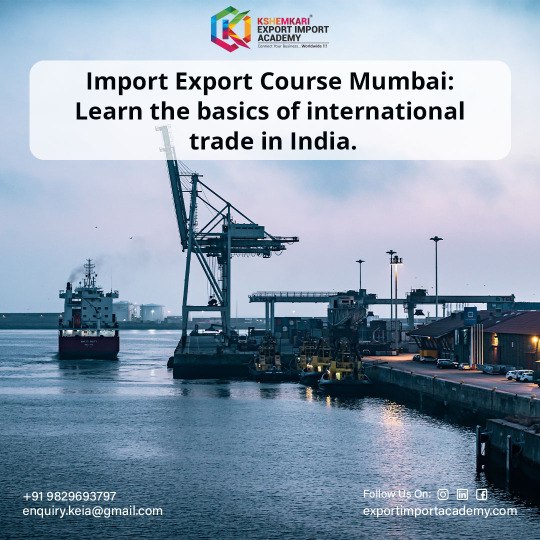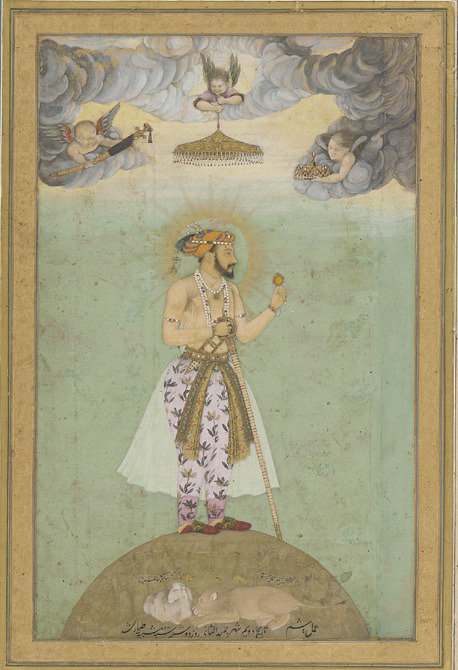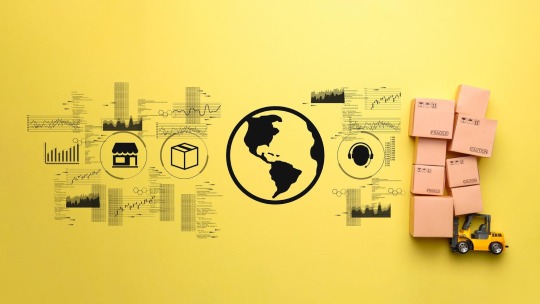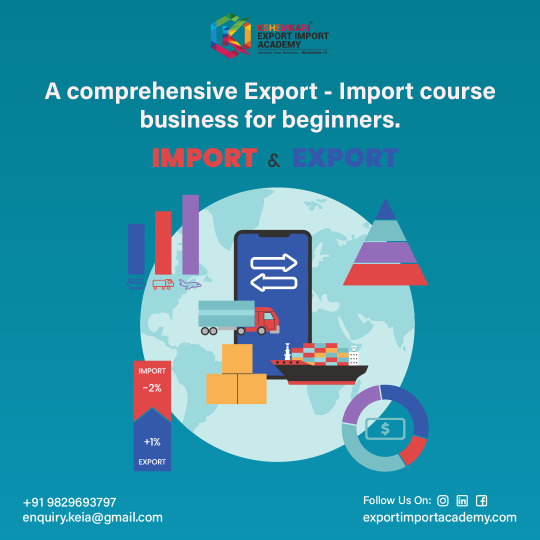#export import course in india
Text
Global Import Export Business and Import Export Management Courses of ICEEL
Import export course are undoubtedly one of the most profitable platforms to perform business activities. Also, it is known to be the safest mode in terms of transactions where the money is secured by both ends, i.e., the person purchasing or importing the good as well as the one selling or exporting the goods and services to other countries.
Import export course Iceelhave discussed many things like what documents are needed for the import procedure in India, the procedure of import and export, documents needed for the export procedure in India, and how exactly the export and import procedure in India. The reason that prompted us to write this blog is that many people are searching for answers to questions like explaining the import and export registration Import export business course procedure for India.
Import export market research in the target country sets the stage for finding potential buyers and preparing essential export documentation. With strict customs inspections and, often, varying duty fees, understanding the intricacies of import-export procedures can be crucial for smooth international trade operations in India. Starting an import and export business is not a difficult task, but it is necessary to comply with the government rules set by a particular country for a smooth flow of material and transactions.
Import export courseprocedure in India is easy if you follow certain criteria as it makes procedures easy and well-managed. In a general license, a person involved in the process of importing can easily import goods from any country, whereas in the individual or a specific license, the goods or services can be imported from specific countries only. These licenses are used for renewable, clearance of the imported materials.
The import-export landscape in India involves a series of well-defined steps, governed by robust regulations. Securing an Importer Exporter Code from the is a crucial initial step for both those looking to import and export goods in India. For imports, after securing a Letter of Credit, you Import export course in Ahmedabad proceed with customs clearance, where a Bill of Entry and other shipping documents are essential.
Import export coursebusiness owner needs to comply with the above-mentioned Import and Export Procedures in India. Apart from this, one must fully study their target market so that they should have an in-depth knowledge of the goods and services which have a demand in a particular country and vice versa. Good knowledge of the import-export market and government rules will allow any company to successfully hit the business and earn huge profits.
There are different methods or procedures that are necessary to collect goods from a foreign market or to sell domestically manufactured products in a foreign market.
.
More Detail Visit us: - https://www.iceel.net/
#export business#import and export courses#import export course#business#import export#import and export#import export course by government of india#import export business
0 notes
Text
0 notes
Text
Import export business in India, Best Import Export Courses, Foreign Trade Management
looking to engage in international trade. To get started in this field, you need to understand the regulations, documentation, logistics, and market dynamics involved. Here are some steps to consider when setting up an import-export business in India. Research and Identify Products: Conduct market research to identify the products you want to import or export. Consider factors like demand, competition, profitability, and legal requirements.
Import Export Course Register your business entity with the appropriate government authorities. In India, you can choose from various types of business structures, such as a sole proprietorship, partnership, limited liability company, or private limited company. Consult a professional to determine the best option for your specific needs. Obtain Importer-Exporter Code Apply for an IEC from the Directorate General of Foreign Trade It is a unique code required for conducting import-export activities in India.

Import and export business Familiarize yourself with customs procedures and documentation requirements. Learn about customs duties, tariffs, exemptions, and other trade-related regulations. You can access this information through the Indian Customs website or seek assistance from customs consultants.
Find Suppliers/Buyers Identify reliable suppliers or buyers for your chosen products. Attend trade fairs, exhibitions, and conferences to network with potential business partners. Utilize online platforms, business directories, and trade portals to connect with international counterparts. Understand the logistics and shipping processes involved in importing or exporting goods. Research freight forwarders, shipping lines, and transportation options to ensure smooth movement of goods between countries.
Import Export Course are Explore financing options and secure appropriate payment methods for international transactions. Consider mechanisms like letters of credit (LC), bank guarantees, and trade finance facilities to mitigate financial risks. Import export business in India Comply with the legal requirements and documentation procedures for import and export. This includes commercial invoices, packing lists, bill of lading/airway bill, certificates of origin, insurance documents, and any specific permits or licenses required for your products. Regarding import-export courses and foreign trade management, there are several options available to enhance your knowledge and skills in this field. Some of the best import-export courses in India include:
These courses provide insights into various aspects of import-export business, including documentation, logistics, market analysis, legal compliance, and international trade finance. Additionally, consider pursuing a degree in international business or global trade management to gain a broader understanding of foreign trade practices.
More Detail Visit us: - https://www.iceel.net/
#import export course#import export course by government of india#import export#import export business#import and export#export business#import and export courses#export trade#import and export business
0 notes
Text

Follow Dr. Vikas Kumar (TEDx speaker, celebrity mentor &marketing strategist) for more.
#drvikaskumar#businessowner#inspiration#motivation#enterpreneurship#business#ancipreneur#philosopher#epictetus#GREEKphilosophy#DrVikasKumar#philosphersstone#goodmorning#morningquotes#motivationalquotes#Global marketing Company#Global marketing management#companies with best marketing strategies in india#Best institute for import export course in india#Export import courses in delhi#importance of export marketing#features of export marketing#Import Export Courses Online#training in international trade#export import practical training#Import and Export For Beginners#Import Export Online Training Programme#export import professional training instructor#Import Export Management Training Program#Marketing strategist
1 note
·
View note
Text
Now Available online and also offline Kshemkari Export Import Academy.
In today's global economy, international trade plays an essential role in the growth and development of the country. India has become an important player in the import and export market with its various products and services. To succeed in this type of business, understanding the intricacies of international trade and the import and export processes is essential. That's where Import and Export courses come in, providing professionals with the knowledge and skills they need to excel in the field.
In this blog, we will explore some of India's best import and export courses, focusing on the Academy at Kshemkari Export Import courses in Delhi.
Kshemkari Export Import Academy is a renowned institution that provides comprehensive export-import training and services. Here are some of the services offered by the academy:
Export-import training programs: The academy provides an online training program designed to equip individuals with the knowledge and skills required to excel in the export-import industry. These programs cover various aspects of international trade, including export-import procedures, documentation, logistics, market research, global marketing, and regulatory compliance.
Interactive online webinars: Kshemkari Export Import Academy conducts live webinars for manufacturers, traders, farmers, students, etc. These webinars are tailored to provide practical insights and solutions related to export-import operations. This includes opportunities, business setup, product selection, and market selection. Join their upcoming live webinar on 21 May at just Rs. 9. Register Now!
International trade guidance: The academy offers guidance and support in international trade. This includes market research, identifying potential export markets, understanding trade regulations and policies, developing export-import strategies, and optimizing operational efficiency.
Documentation and compliance support: Kshemkari guides you on export-import documentation, preparing commercial invoices, packing lists, shipping instructions, and customs declarations. They also support complying with various legal and regulatory requirements, such as export controls, customs procedures, and trade agreements.
Export-Import Business Setup Assistance: The academy guides setting up an export-import business for entrepreneurs and companies looking to venture into the export-import domain. This includes assistance with registration, licensing, identifying product opportunities, how to find reliable suppliers or buyers and establish effective trade networks.
Export-Import Research and Market Intelligence: Kshemkari Export Import Academy educates you on how to understand global market trends, identify potential buyers or suppliers, evaluate the competition, and make informed business decisions. They provide:
Market intelligence reports.
Trade statistics.
Industry-specific insights to support export-import activities.
Online resources and e-learning: The academy provides online resources, including articles, blogs, e-books, and videos, covering various topics related to export-import. They also offer e-learning courses and webinars, allowing individuals to conveniently enhance their knowledge and skills.
Kshemkari Export Import Academy is affiliated with various prestigious organizations and trade bodies. It offers one of the Best Import Export Courses In India.

Indian Export Organizations (IEO) and the International Chamber of Commerce (ICC). These affiliations further validate the credibility and quality of the courses offered. In conclusion, the import-export industry presents immense opportunities for growth and success in India.
A strong foundation in import-export procedures and international trade is crucial to maximize these opportunities.
Kshemkari Export Import courses in Delhi are among India's Best Import Export Courses.
Whether you are a fresh graduate or a working professional looking to enhance your career prospects, investing in an import-export course can be a stepping stone toward a rewarding and fulfilling career in international trade. Kshemkari Academy's upcoming online export-import training program starts on 27 May. Enroll today!
#Export Import Course#Import Export Course Mumbai#Import Export Course In Pune#Best Import Export Courses In India
0 notes
Note
hey you might've been asked this before sorry if so, but have you read or do you have any thoughts on A short history of Trans Misogyny?
I have read it! I have a few thoughts.
I think it's a strong and important work that compiles historical archives into sharp analyses of how "trans misogyny" (using Jules Gill-Peterson's spacing) is not a recent phenomenon but a globalized structure with centuries of history. I also think it's flawed, for reasons I'll get into after a quick summary for those who haven't had the chance to read it yet.
JGP divides the book into three main chapters, the first on the notion of "trans panic". There, she traces how variants of this anxiety with the trans-feminized subject have presented—to deadly effect, for the subject—in such different settings as early colonial India, the colonization of the Americas, the racialized interactions between US soldiers stationed in the Philippines and the local trans women living there, and of course the contemporary United States itself. In every case she analyzes this "panic" as the reaction of the capitalist colonial enterprise to the conceptual threat that the trans-feminized subject poses; we are a destabilizing entity, a gender glitch that undermines the rigid guarantees of the patriarchal order maintaining capitalism. Punishment follows.
The second chapter is my favourite, and considers the relationship between transfeminine life and sex work. I posted a concluding excerpt but the thrust of the chapter is this: that the relegation of so many trans women and trans-feminized people to sex work, while accompanied by the derogation and degradation that is associated with sex work, is not itself the mere result of that degradation inflicted upon the subject. In other words, it is not out of pure helplessness and abjection that so many trans-feminized people are involved in sex work. Rather, sex work is a deliberate and calculated choice made by many trans-feminized people in increasingly service-based economies that present limited, often peripheralized, feminized, and/or reproductive, options for paid labour. Paired with a pretty bit of critical confabulation about the histories of Black trans-feminized people travelling the US in the 19th century, I think this made for great reading.
In her third chapter, JGP narrativizes the 20th century relationship between the "gay" and "trans" movements in north america—scare quoted precisely because the two went hand-in-hand for much of their history. She emphasizes this connection, not merely an embedding of one community within another but the tangled mutualism of experiences and subjectivities that co-constituted one another, though not without tension. Then came the liberal capture of the gay rights movement around the 70s, which brought about the famous clashes between the radicalisms of Silvia Rivera and Marsha P Johnson (neither of whom, JGP notes, ever described themselves as trans women) and the institutions of gay liberalism that desired subsumption into the folds of capital. This is a "remember your history" type of chapter, and well-put.
I think JGP is correct to insist, in her introduction, on the globalizing-in-a-destructive-sense effects of the colonial export of trans womanhood. It is, after all, an identity conceived only mid-century to make sense of the medicalized trans subject; and "gender identity" itself (as JGP describes in Histories of the Transgender Child) is a psychomedical concept conceived to rein in the epistemic instability of trans existence. This is critical to keep in mind! But I also think JGP makes a few mistakes, and one of them has to do with this point.
In her first chapter, under the discussion of trans misogyny in colonial India, JGP of course uses the example of the hijra. Unfortunately, she commits two fundamental errors in her use: she mythologizes, however ambiguously, the "ascetic" lives of hijra prior to the arrival of British colonialism; and she says "it's important to say that hijras were not then—and are not today—transgender". In the first place, the reference to the "ascetism" of hijra life prior to the violence of colonialism is evocative of "third-gender" idealizations of primeval gender subjectivities. To put the problem simply: it's well and good to describe the "ritual" roles of gendered subjects people might try to construe contemporarily as "trans women", the priestesses and oracles and divinities of yore. But it is best not to do so too loftily. Being assigned to a particular form of ritualistic reproductive labour because of one's failure to be a man and inability to perform the primary reproductive labour of womanhood-proper is the very marker of the trans-feminized subject. "Ascetism" here obviates the reality that it wasn't all peachy before (I recommend reading Romancing the Transgender Native on this one). Meanwhile, in the after, it is just wrong that hijra are universally not transgender. Many organize specifically under the banners of transfeminism. It's a shame that JGP insists on keeping the trans-feminized life of hijra so firmly demarcated from what she herself acknowledges is globalized transness.
My second big complaint with the book is JGP's slip into a trap I have complained about many times: the equivocation of transfemininity with femininity (do you see why I'm not fond of being described as "transfem"?). She diagnoses the root of transmisogyny as a reaction to the femininity of trans women and other trans-feminized subjects. In this respect she explicitly subscribes to a form of mujerísima, and of the trans-feminized subject as "the most feminine" and (equivalent, as far as she's concerned) "the most woman". Moreover, she locates transfeminist liberation in a singular embrace of mujerísima as descriptive of trans-feminized subjectivity. As I've discussed previously, I think this is a misdiagnosis. Feminization is, of course, something that is done to people; it is certainly the case that the trans-feminized subject is in this way feminized for perceived gender-failure. This subject may simultaneously embrace feminized ways of being for all sorts of reasons. In both cases I think the feminization follows from, rather than precedes, the trans misogyny and trans-feminization, and there is a fair bit of masculinization as de-gendering at play too, to say nothing of the deliberate embrace of masculinity by "trans-feminized" subjects. Masculinity and femininity are already technologies of gender normalization—they are applied against gender deviation and adapted to by the gender deviant. The deviation happens first, in the failure to adhere to the expectations of gender assignment, and I don't think these expectations can be summarized by either masculinity or femininity alone. I think JGP is effectively describing the experience of many trans-feminized people, but I do not think what she presents can be the universalized locus of trans liberation she seems to want it to be.
Now for a pettier complaint that I've made before, but one that I think surfaces JGP's academic context. In her introduction she says:
In truth, everyone is implicated in and shaped by trans misogyny. There is no one who is purely affected by it to the point of living in a state of total victimization, just as there is no one who lives entirely exempt from its machinations. There is no perfect language to be discovered, or invented, to solve the problem of trans misogyny by labeling its proper perpetrator and victim.
Agreed that "there is no perfect language to be discovered"! But JGP is clearly critical of TMA/TME language here. Strange, then, that less than ten pages later she says this:
this book adds the phrase trans-feminized to describe what happens to groups subjected to trans misogyny though they did not, or still do not, wish to be known as transgender women.
So JGP believes it is coherent to talk about "groups subjected to trans misogyny", which she thinks consists of the union of trans women and what she called "trans-feminized" groups. If this is to be coherent, there must be groups not subjected to trans misogny. So we've come around to transmisogyny-subjected and not transmisogyny-subjected. Look: you cannot effectively theorize about transmisogyny without recognizing that its logic paints a particular target, and you will need to come up with a concise way of making this distinction. But JGP dismissing TMA/TME with skepticism about "perfect language" and immediately coining new language (basically TMS/not TMS) to solve the problem she un-solved by rejecting TMA/TME... it smells of a sloppy attempt to make a rhetorical point rather than theoretical rigour. It's frustrating.
I have other minor gripes, like her artificial separation of "trans women" from "nonbinary people" (cf. countless posts on here lamenting the narrow forms of existence granted TMA people if we want recognition as-such!) or her suggestion that "a politics of overcoming the gender binary" is mutually exclusive from rather than necessarily involved with struggles around "prison abolition, police violence, and sex work". Little things that give me the sense of theoretical tunnel-vision. But I don't think all this compromises the book's strengths as a work of broad historical analysis. I would simply not take every one of its claims as authoritative. Definitely give it a read if you have the chance, especially for the second and third chapters.
#ask answer#jules gill-peterson#(i haven't been asked this before ty for asking <3 🐐)#note that this was mostly off the cuff except what i had taken pictures of bc i left the book in toronto for my mom to read
254 notes
·
View notes
Note
How did cotton win over linen anyway?
In short, colonialism, slavery and the industrial revolution. In length:
Cotton doesn't grow in Europe so before the Modern Era, cotton was rare and used in small quantities for specific purposes (lining doublets for example). The thing with cotton is, that's it can be printed with dye very easily. The colors are bright and they don't fade easily. With wool and silk fabrics, which were the more traditional fabrics for outer wear in Europe (silk for upper classes of course), patterns usually needed to be embroidered or woven to the cloth to last, which was very expensive. Wool is extremely hard to print to anything detailed that would stay even with modern technology. Silk can be printed easily today with screen printing, but before late 18th century the technique wasn't known in western world (it was invented in China a millenium ago) and the available methods didn't yeld good results.
So when in the late 17th century European trading companies were establishing trading posts in India, a huge producer of cotton fabrics, suddenly cotton was much more available in Europe. Indian calico cotton, which was sturdy and cheap and was painted or printed with colorful and intricate floral patters, chintz, especially caught on and became very fashionable. The popular Orientalism of the time also contributed to it becoming fasionable, chintz was seen as "exotic" and therefore appealing.

Here's a typical calico jacket from late 18th century. The ones in European markets often had white background, but red background was also fairly common.
The problem with this was that this was not great for the business of the European fabric producers, especially silk producers in France and wool producers in England, who before were dominating the European textile market and didn't like that they now had competition. So European countries imposed trade restrictions for Indian cotton, England banning cotton almost fully in 1721. Since the introduction of Indian cottons, there had been attempts to recreate it in Europe with little success. They didn't have nearly advanced enough fabric printing and cotton weaving techniques to match the level of Indian calico. Cotton trade with India didn't end though. The European trading companies would export Indian cottons to West African market to fund the trans-Atlantic slave trade that was growing quickly. European cottons were also imported to Africa. At first they didn't have great demand as they were so lacking compared to Indian cotton, but by the mid 1700s quality of English cotton had improved enough to be competitive.
Inventions in industrial textile machinery, specifically spinning jenny in 1780s and water frame in 1770s, would finally give England the advantages they needed to conquer the cotton market. These inventions allowed producing very cheap but good quality cotton and fabric printing, which would finally produce decent imitations of Indian calico in large quantities. Around the same time in mid 1700s, The East Indian Company had taken over Bengal and soon following most of the Indian sub-continent, effectively putting it under British colonial rule (but with a corporate rule dystopian twist). So when industrialized English cotton took over the market, The East India Company would suppress Indian textile industry to utilize Indian raw cotton production for English textile industry and then import cotton textiles back to India. In 1750s India's exports were mainly fine cotton and silk, but during the next century Indian export would become mostly raw materials. They effectively de-industrialized India to industrialize England further.
India, most notably Bengal area, had been an international textile hub for millennia, producing the finest cottons and silks with extremely advance techniques. Loosing cotton textile industry devastated Indian local economies and eradicated many traditional textile craft skills. Perhaps the most glaring example is that of Dhaka muslin. Named after the city in Bengal it was produced in, it was extremely fine and thin cotton requiring very complicated and time consuming spinning process, painstakingly meticulous hand-weaving process and a very specific breed of cotton. It was basically transparent as seen depicted in this Mughal painting from early 17th century.

It was used by e.g. the ancient Greeks, Mughal emperors and, while the methods and it's production was systematically being destroyed by the British to squash competition, it became super fashionable in Europe. It was extremely expensive, even more so than silk, which is probably why it became so popular among the rich. In 1780s Marie Antoinette famously and scandalously wore chemise a la reine made from multiple layers of Dhaka muslin. In 1790s, when the empire silhouette took over, it became even more popular, continuing to the very early 1800s, till Dhaka muslin production fully collapsed and the knowledge and skill to produce it were lost. But earlier this year, after years lasting research to revive the Dhaka muslin funded by Bangladeshi government, they actually recreated it after finding the right right cotton plant and gathering spinners and weavers skilled in traditional craft to train with it. (It's super cool and I'm making a whole post about it (it has been in the making for months now) so I won't extend this post more.)


Marie Antoinette in the famous painting with wearing Dhaka muslin in 1783, and empress Joséphine Bonaparte in 1801 also wearing Dhaka muslin.
While the trans-Atlantic slave trade was partly funded by the cotton trade and industrial English cotton, the slave trade would also be used to bolster the emerging English cotton industry by forcing African slaves to work in the cotton plantations of Southern US. This produced even more (and cheaper (again slave labor)) raw material, which allowed the quick upward scaling of the cotton factories in Britain. Cotton was what really kicked off the industrial revolution, and it started in England, because they colonized their biggest competitor India and therefore were able to take hold of the whole cotton market and fund rapid industrialization.
Eventually the availability of cotton, increase in ready-made clothing and the luxurious reputation of cotton lead to cotton underwear replacing linen underwear (and eventually sheets) (the far superior option for the reasons I talked about here) in early Victorian Era. Before Victorian era underwear was very practical, just simple rectangles and triangles sewn together. It was just meant to protect the outer clothing and the skin, and it wasn't seen anyway, so why put the relatively scarce resources into making it pretty? Well, by the mid 1800s England was basically fully industrialized and resource were not scarce anymore. Middle class was increasing during the Victorian Era and, after the hard won battles of the workers movement, the conditions of workers was improving a bit. That combined with decrease in prices of clothing, most people were able to partake in fashion. This of course led to the upper classes finding new ways to separate themselves from lower classes. One of these things was getting fancy underwear. Fine cotton kept the fancy reputation it had gained first as an exotic new commodity in late 17th century and then in Regency Era as the extremely expensive fabric of queens and empresses. Cotton also is softer than linen, and therefore was seen as more luxurious against skin. So cotton shifts became the fancier shifts. At the same time cotton drawers were becoming common additional underwear for women.
It wouldn't stay as an upper class thing, because as said cotton was cheap and available. Ready-made clothing also helped spread the fancier cotton underwear, as then you could buy fairly cheaply pretty underwear and you didn't even have to put extra effort into it's decoration. At the same time cotton industry was massive and powerful and very much eager to promote cotton underwear as it would make a very steady and long lasting demand for cotton.
In conclusion, cotton has a dark and bloody history and it didn't become the standard underwear fabric for very good reasons.
Here's couple of excellent sources regarding the history of cotton industry:
The European Response to Indian Cottons, Prasannan Parthasarathi
INDIAN COTTON MILLS AND THE BRITISH ECONOMIC POLICY, 1854-1894, Rajib Lochan Sahoo
#i have fixed the wording in the beginning so it doesn't sound like i'm saying cotton in general dyed better than wool or silk#answers#fashion history#historical fashion#history#textile history#dress history#historical clothing#indian history#colonial history#indian textiles#cotton#slavery
2K notes
·
View notes
Quote
California is the peak of Western culture. People are finished with life, that’s why there are so many cults: Hare Krishna, Moonies, EST, Esalen—all kinds of strange things. You have just to be a little bold and you can make a cult out of anything. Primal therapy, or scream… Nowhere ever in the whole world was anybody so inventive as to make a scream a religion! But in California you can do anything. Hugging therapy! And people are doing it, and paying for it, for hugging therapy! Hugging strangers—you are doing the hugging and somebody else is collecting the fee. You both are giving the fee to a third person, and you are doing the work! It is really great.
I was reading a news article some five, six years back. I don’t remember exactly what the therapy was called but I remember the picture that was in the magazine. It was of a naked man going on all fours with his tongue drooping out like a dog, barking. And you have to pay for it! You do the whole job… And people were getting high on it. What else to do? When you have paid two hundred and fifty dollars for being a dog and barking, then it is better to say that you ‘got it.’
Now people are tired of this too. Esalen is dying, EST is finished. EST has been trying—Werner Erhard came to see me in Poona because at that time it had started falling. In California nothing lasts more than ten years. Every fashion… these are all fashions, but no fashion can last long.
So Werner Erhard was in search of something—and he found it. In the East he saw the hungry people so he brought back home the ‘Hunger Project,’ and he started claiming that within ten years there would not be a single hungry human being on the earth.
People were donating, and nobody bothered to ask, ‘What are you saying? Have you calculated how many people there are? Have you calculated how many hungry people there are? Have you calculated in ten years how many more hungry people will be there? And how many collections can you have?’ But all those collections simply disappeared. Hunger is there; it has not disappeared—it has doubled!
But these so-called new cultists are not any better than the politicians. Henry Kissinger was saying exactly the same thing when he was in power, that within ten years there would not be a hungry child around the globe. And nobody asks these people, ‘Now five years have passed; at least half the hungry people should have disappeared, because otherwise how, within another five years, are things going to change? Hungry people have doubled. Hunger has not disappeared; Henry Kissinger has disappeared! Who knows where this guy is? And who cares!
Werner Erhard cheated people in every possible way. And the beauty of this is, you cheat people in every possible way.
Werner Erhard is a Jew, but he changed his name to a German name because it would be difficult for a Jew to exploit Christians; for that a German name is far better. In some way everything imported is always better. I used to think that this stupid idea existed only in India, but that is not the case. In America nobody bothers with the American guru, but imported from India?—he must be a great guru. Of course India cannot export cars and high technology, but it can export great gurus. And it goes on exporting them—and they all end up in California.
When Sheela was looking for a place for your commune, I told her, ‘Beware of California; just keep away from California.’ She said, ‘Why?’ I said, ‘You don’t ask why; you just keep away. Just forget that California exists.’
I don’t want to be counted amongst Indian gurus because I am neither an Indian, nor am I a guru. But what can you do with these crackpot media people? They start calling you something and that’s what you become.
Where is Werner Erhard now? With hunger disappearing has he also disappeared? Authentic people?—he left his father, mother, his wife, his children, without even telling them that he was going away. He simply escaped, moving thousands of miles away, changed his name, may have changed his hair-do, clothes, and became Werner Erhard. And his parents, his wife, his children were all dependent on him, they were starving. And he was proposing a hunger project—‘within ten years, hunger will disappear from the world.’
These people are not different from politicians—and cannot be, because this is also a power trip. Things that they are telling people not to do, they have been doing exactly those same things.
Osho (From Misery to Enlightenment)
#osho#cult#EST#esalen#werner erhard#personal development#california#therapy#hugging#money#guru#india#hypocrisy#large group awareness training#lbotca
5 notes
·
View notes
Text
Day 1: Thursday 9th March 2023
Jabs done ✅
Visa done ✅
Packing done ✅
Except for the hand luggage !
T shirts, jeans, shirts, socks, scarves, bathroom stuff, all neatly placed in the suitcases, whether they will come back home neatly packed is another matter though !
Everything else is on the dining room table awaiting incarceration in the hand luggage, which weighs nearly as much as the main luggage. Mustn’t forget the adapter plug plus the 5 different chargers for all the various appliances we are taking with us, I Pad, camera, smart watch, air pods, phone. When did packing get so technical ? Then there is the passports, flight information, no tickets of course, not in this day age, sterling not currency as India does not allow import or export of the Rupee, credit cards , sun glasses, spare glasses, extra spare glasses and finally a pen. I mustn’t forget a pen, that’s very important because there is always some form or other that needs filling out on the aircraft.
There is no food in the house, so we shall have a breakfast of “ if it’s “, if it’s in the house we will have it, if it’s not in the house we won’t !
Once we are ready to leave we can look forward to negotiating the illustrious M25, as it’s snowing, read light flurries, on the other side of the Downs, we are bound to encounter some kind of disruption, perhaps a road or two closed? Perhaps a minor prang where some careless “ the slow down sign doesn’t actually mean me “ driver, drives too fast, perhaps our flight will be cancelled? Who knows ?
Thankfully we are flying with Virgin, so the chances of actually getting off the ground will be statistically higher than if we were flying with British Airways so that’s a positive.
Anyway, next stop Terminal 3 at Heathrow Airport, our flight is at 17.55 to arrive in Delhi at 08.15
2 notes
·
View notes
Text
Certificate Program in International Business Management, Import Export Courses
Import and export courses A Certificate Program in International Business Management is a short-term educational program that focuses on providing participants with essential knowledge and skills related to the field of international business. These programs are designed to equip individuals with the tools necessary to understand and navigate the complexities of conducting business on a global scale.
Duration Certificate programs are usually shorter in duration compared to degree programs and can range from a few weeks to a few months, depending on the institution offering the program. The curriculum typically covers fundamental concepts in international business, including international marketing, cross-cultural management, global supply chain management, international finance, trade regulations, and international business strategy.

Target Audience Certificate Program In International Business Management are often targeted at working professionals and individuals who want to gain specific knowledge and skills without committing to a full-fledged degree program. Practical Focus these programs tend to have a practical orientation, emphasizing real-world applications and case studies to help participants understand the challenges and opportunities involved in international business.
The instructors may be professionals with practical experience in the field or academics with expertise in international business management. Admission Requirements Admission requirements for certificate programs can vary, but they typically have more relaxed prerequisites compared to degree programs. Some programs may require prior business-related experience or education, while others may be open to individuals from various backgrounds.
Export Import Certificate Program Career Benefits Completing a Certificate Program in International Business Management can enhance career prospects for participants seeking roles in multinational corporations, export-import companies, international trade organizations, and other global business entities. Pathway to Further Education For those who wish to pursue higher education, a certificate program can serve as a stepping stone to more advanced degrees like a Bachelor's or Master's in International Business or related fields.
When considering a Certificate Program in International Business Management, it's essential to research the specific program's content, reputation, and accreditation to ensure that it aligns with your career goals and provides quality education. Different institutions or educational providers may offer variations in curriculum, scheduling, and course delivery, so it's important to find one that suits your needs and preferences.
More Detail Visit us: - https://www.iceel.net/
https://www.iceel.net/international-business-management-diploma-course.php
https://www.iceel.net/export-import-management-certificate-course.php
https://www.iceel.net/master-in-international-trade-management-course.php

#import export course#import export course by government of india#import export#import export business#import and export#export business#import and export courses#import and export business#import export certification course#import and export training courses#diploma in import and export
0 notes
Text
Achieving Success Through Supply Chain Management Training in Bangladesh
Bangladesh is a country of immense potential, but it has struggled to leverage that potential due to inadequate supply chain management training. As the world globalizes, supply chain management has become increasingly important for businesses in both developed and developing countries. For Bangladesh, this opens up opportunities to create jobs, increase exports and nurture economic growth.
But what does it take for Bangladesh to become a leader in the field of supply chain management? In this blog post, we will explore how training and education can help drive forward success in this area and help grow the economy of Bangladesh.

What is Supply Chain Management?
Supply chain management (SCM) is the process of planning, implementing, and controlling the operations of a company's supply chain. The main goal of SCM is to ensure that the company's products are delivered to customers in a timely and efficient manner.
SCM training can help Bangladesh-based companies improve their supply chains and achieve success. Through SCM training, companies can learn how to better plan and control their supply chains, which can lead to improved customer satisfaction and increased profits.

The Importance of Supply Chain Management Training
The Bangladesh Garment Manufacturers and Exporters Association (BGMEA) is committed to ensuring that its members are able to access the best possible supply chain management training. In order to achieve this, the BGMEA has partnered with a number of leading international organizations to offer a range of courses which cover all aspects of supply chain management.
The BGMEA recognizes that an efficient and effective supply chain is essential to the success of the garment industry in Bangladesh. In order to keep up with the ever-changing requirements of the global market, it is essential that Bangladeshi manufacturers have access to the latest information and techniques. The courses offered by the BGMEA will ensure that members are able to stay ahead of the competition and continue to meet the demands of buyers.
The courses on offer include:
- An Introduction to Supply Chain Management
- Principles of Supply Chain Management
- Fundamentals of Purchasing and Procurement
- Supply Chain Management for Apparel Brands and Retailers
- Sourcing Strategies for Apparel Manufacturers
- Lean Manufacturing for Apparel factories
- Quality Control and Assurance in Apparel Production
Each course is designed to provide participants with the knowledge and skills they need to improve their operations and contribute to the success of their company. The courses are delivered by experienced instructors who are experts in their field, and who use a variety of teaching methods including lectures, case studies, group work, and individual tutorials.
The Current State of Supply Chain Management in Bangladesh
The current state of supply chain management in Bangladesh can be best described as fledgling. Despite the fact that the country has been making strides in recent years to improve its logistics infrastructure, the overall level of development is still relatively low. This is particularly true when compared to other countries in the region such as India and China.
However, it is important to note that there are some bright spots. In particular, the Bangladeshi government has been investing heavily in training programs for supply chain management. These programs are designed to help improve the skills of those working in the logistics industry and to raise awareness about best practices.
There is still a long way to go before Bangladesh can claim to have a world-class supply chain management system. However, with continued investment and commitment from both the public and private sectors, it is certainly possible that the country will be able to make significant progress in this area in the years to come.
The Benefits of Supply Chain Management Training in Bangladesh
The benefits of supply chain management training in Bangladesh are numerous. Perhaps most importantly, it helps to improve communication and coordination between different parts of the supply chain, which can lead to improved efficiencies and cost savings. In addition, supply chain management training can help to improve supplier relationships, as well as customer service and satisfaction levels.
In today's business environment, having a well-trained and efficient supply chain management team is critical to success. By investing in quality training for your team, you can ensure that your company is able to keep up with the competition and maintain a high level of customer satisfaction.

The Different Types of Supply Chain Management Training in Bangladesh
Supply chain management (SCM) is becoming increasingly important in today's globalized world, particularly for firms in the developing world. Bangladesh is no exception; training in SCM is necessary to keep up with the challenges of an ever-changing business landscape. This article will discuss the different types of SCM training available in Bangladesh, and how each of these courses can help organizations improve their performance.
1. Traditional supply chain management training: This type of training covers the basic concepts and methods of supply chain management. It is typically delivered in a classroom setting, and may include lectures, case studies, and group discussions.
2. Online supply chain management training: This type of training is delivered online, and can be self-paced or synchronous (taught in real-time with a live instructor). It may include videos, readings, quizzes, and simulations.
3. Supply chain management certification programs: These programs provide comprehensive training in supply chain management principles and practices. They often include an exam at the end, and successful completion can lead to professional certification.
4. On-the-job training: Many organizations offer on-the-job training programs for their employees. This type of training can be tailored to the specific needs of the organization, and allows employees to learn while they are working.

The Challenges of Implementing Supply Chain Management Training in Bangladesh
In Bangladesh, the challenges of implementing supply chain management training are many and varied. The first challenge is the lack of awareness of the importance of supply chain management among the general population. This is compounded by the fact that there is no formal education or training available in Bangladesh on this topic. As a result, there are few people who are knowledgeable about supply chain management and its potential benefits.
The second challenge is the lack of infrastructure and resources to support supply chain management training. In Bangladesh, most businesses operate on a small scale and do not have the necessary resources to invest in training their employees on supply chain management. Additionally, there is a lack of qualified trainers who are able to provide quality training on this topic.
The third challenge is the cultural barriers to implementing supply chain management training in Bangladesh. The culture in Bangladesh places a high value on personal relationships and networking. This can make it difficult to implement changes within an organization, such as introducing new processes or technologies related to supply chain management. Additionally, the hierarchical nature of Bangladeshi society can make it difficult to get buy-in from all levels of an organization for new initiatives.
Despite these challenges, there are also opportunities for successful implementation of supply chain management training in Bangladesh. One opportunity lies in the increasing globalization of business and trade. As more businesses operate internationally, they will need employees who are trained in international standards and practices related to supply chain management. Additionally, the growth of the Bangladesh economy provides opportunities
Tips for Successful Supply Chain Management Training
Having an effective supply chain management training program can be a great resource for any organization. It is essential to ensure that proper training is conducted in order to maximize efficiency and productivity. With the right guidance and resources, companies can build a successful supply chain management program that benefits the entire organization. Below we will discuss some tips for successful supply chain management training that can help you get started on the right track.
1. Define your goals: What do you hope to achieve through supply chain management training? Is it to improve your knowledge of the subject so that you can be more effective in your current role? Or are you looking to advance your career and move into a managerial position? Once you know what your goals are, you can tailor your training accordingly.
2. Do your research: There are many different types of supply chain management training programs out there. Before enrolling in one, do some research to make sure it's a good fit for you. Ask yourself what the program covers, how long it is, and whether it's offered online or in-person.
3. Consider your schedule: Supply chain management training can be intensive, so make sure you have the time to commit to it. If you're working full-time while taking classes, consider an online program that offers more flexibility.
4. Set aside time for study: In addition to attending classes, you'll need to set aside time for independent study. Make sure you're prepared to commit the necessary time to reading textbooks and other course materials, as well as completing assignments.
5. Stay organized: Supply chain management involves a lot of moving parts, so it's important to stay organized throughout your training. Keep track of deadlines and due dates, and create a system for organizing course materials so that you can easily find what you need when you need it.

How to Overcome the Challenges of Supply Chain Management Training in Bangladesh
In order to overcome the challenges of supply chain management training in Bangladesh, it is important to first understand the specific challenges that exist within the country. One of the biggest challenges is the lack of a centralized government body or institution that can provide cohesive and standardized training. This often results in a fragmented approach to training, with different organizations and companies using their own methods, which can make it difficult for employees to receive a consistent education.
Another challenge is the limited resources that are available for training. This includes both financial resources and skilled personnel. As a result, many supply chain management programs in Bangladesh are forced to operate on a shoestring budget, which can impact the quality of instruction and learning materials. In addition, there is often a shortage of qualified trainers, which can make it difficult to find someone with the necessary knowledge and experience to effectively teach employees.
Despite these challenges, there are also several opportunities that exist for those interested in pursuing supply chain management training in Bangladesh. One of the biggest advantages is the country's vast pool of potential workers. With over 160 million people living in Bangladesh, there is a large labor force that can be tapped into for supply chain management positions. In addition, Bangladesh has a rapidly growing economy and its manufacturing sector is expected to expand significantly in the coming years. This provides an opportunity for those with supply chain management training to find employment with companies that are looking to capitalize on this growth.
Overall, while there are some challenges associated with supply chain
Conclusion
In conclusion, supply chain management training in Bangladesh can help businesses achieve success. With proper training and resources, businesses can become more efficient and effective in their operations thus gaining a competitive edge over other companies. It is essential for organizations to invest in the right technology and personnel to ensure that they are well-prepared for the ever-evolving business environment. Ultimately, it is up to each business's leadership team to recognize the importance of having strong supply chain management processes and provide necessary support towards successful supply chain implementations.
#Enroute International Limited#Managed Service#People Outsourcing#Payroll Service#Facility Management#Events Activation#Recruitment Service#Talent Sourcing#Headhunting Solution#HR Consulting#Skills Recruitment#Pre-employment verification#Background Verification#Executive Education#Leadership Executive Coaching#Customized Program#Consultancy Service#Market Development Service#Digital Lab#Character Licensing#Capacity Development#BPO Company#Business Process Outsourcing Company#Business Process Outsourcing Organization#Business Process Outsourcing Bangladesh#E-learning#Open Training#Skills Training#Executive Coaching#Customized Training
5 notes
·
View notes
Text
The Legality of Human Bones and Skeletons for Sale
In the United States, there are several ethical concerns regarding the trade in human remains. This article explores the legality of human bones and skulls for sale and outlines the ethical considerations involved in the trade. You'll also learn about the sources of human remains and the demand for skeletal specimens for medical research and education.
Legality of owning and trading human remains in the United States
Many states have laws governing the commodification of human remains, but these laws are complicated and hard to interpret. An attorney at the Louisiana Department of Justice said the laws are extremely complex and ambiguous. Moreover, there is no centralized resource on the Internet that allows researchers to examine the legality of owning and trading human remains state-by-state. Hence, academics are unable to give concrete examples of state laws.

The legality of owning and trading human remains is an important issue. Though some states have banned this practice, it is still legal in other states. The trade in human remains is an example of a form of unlicensed trade and has many negative aspects. It is highly recommended that individuals avoid such businesses.
While federal law does not prohibit the trade or ownership of human remains, a few states have laws restricting the import and export of human bones and skulls. In New York, Georgia and Tennessee, the sale or import of human remains is illegal. This also applies to Native American remains. Native American remains are protected by the Native American Graves Protection and Repatriation Act.
Sources of human remains
The global human remains trade is driven by the growing demand of medical schools and private collectors. However, there are a few key issues that make the trade problematic. First of all, it perpetuates cultural practices and disrespect for the dead. Second, it revives a dark Colonial era practice of bone-collecting. Third, there are reports of grave-robbery. In some cases, people steal human remains to sell them for a profit.
The industry is often corrupt and involves the powerful collecting the powerless. Most of the time, these bones are from Indigenous and Brown people. Other times, they are taken from graves or sacred sites. In addition, the trade often involves scientific racism and filling medical schools. And third, there are ethical issues involved.
Human remains trade is also linked to grave-robbing. This practice is illegal unless someone has a license to disturb graves.
Demand for skeletons in medical education
Skeletons are used by medical students to conduct practical experiments and examinations. There is a high demand for human skeletons from overseas institutions and colleges. A doctor based in Kolkata said that the medical schools in India were unable to meet the growing demand for skeletons. However, some Indian skeletons have been exported to Thailand and Japan.
Skeletons have long been used in medical education. In the Renaissance, Andreas Vesalius, a hotshot Renaissance scientist, published his famous book De humani corporis fabrica before he was thirty. Vesalius was a skeptic of the medical establishment and regarded skeleton-making as a dirty and difficult task.
Skeletons are an essential part of the medical education process. Students spend 18 months studying human anatomy and undergo exams worth 500 marks to test their knowledge. There are dozens of public and private medical colleges in India. A total of 13 public medical colleges offer about 3,162 seats to students pursuing the BDS course. There are also nine private dental colleges with about 1,280 seats.
Ethics of collecting human skulls
A London curiosity shop is trying to crowdfund the purchase of a Peruvian mummy. Although not King Tut, this mummy is likely an adult. It has been described as "crunchy" by one museum visitor. The shop also offers other objects made from human remains, including Ouija board planchettes and wallets.

The ethics of collecting Human Bones for Sale skulls are complicated. While some auction houses have banned the sale of body parts, this practice continues to occur in many prestigious auction houses. Despite the fact that dry human remains can be easily transported and stored, the danger of selling human remains is real. Unfortunately, cases like Parker's skull will occur again. The skull was removed from the body of a criminal.
Although there are no federal laws prohibiting the sale of human remains, there are many laws designed to protect the dead's dignity. One such law is in the Canadian Criminal Code, sections 182: "Dignity of the dead."
3 notes
·
View notes
Text
Best International Business & Foreign Trade Management Education Training Institute

It seems like interested in learning about import-export courses and the import-export business, particularly in the context of India. Import-export courses provide knowledge and training on various aspects of international trade, including documentation, logistics, and customs regulations, and market analysis. These courses can be beneficial for individuals looking to start or expand their import-export business.
In India the government offers several initiatives and programs to promote import-export activities and provide relevant training. The Ministry of Commerce and Industry, Government of India, through its various agencies, provides support and resources to aspiring importers and exporters. To find import-export courses offered by the government of India, you can explore the following options:
Import export business opportunities Indian Institute of Foreign Trade IIFT is a premier institute in India that offers courses in international business and trade. They provide specialized programs on export-import management. Export Promotion Councils: Various export promotion councils and trade bodies in India conduct training programs and workshops on import-export procedures and related topics. These include the Federation of Indian Export Organizations (FIEO) and various commodity-specific councils. Indian Institute of Packaging IIP offers courses on packaging and allied fields, which are crucial aspects of the import-export business.
Indian Institute of Entrepreneurship conducts programs to foster entrepreneurship and provides training on various aspects of starting and managing an import-export business. It's important to note that while the government of India offers resources and training programs, there are also private institutes and organizations that provide import-export courses. These can be found through online research or by contacting relevant trade associations and industry bodies.
When starting an import export certification course, it is crucial to understand the regulations, licensing requirements, and documentation processes specific to the country you are operating in. You may need to register your business, obtain necessary permits and licenses, and comply with customs regulations. It is advisable to consult with professionals or seek legal advice to ensure compliance with all relevant laws and regulations.
Remember that import-export business involves dealing with international markets and requires a good understanding of global trade dynamics, market research, negotiation skills, and logistics management. Continuous learning and staying updated with changes in regulations and market trends are essential for success in this field.
More Detail Visit us: - https://www.iceel.net/
#import export course#import export course by government of india#import export#import export business#import and export#export business#import and export courses#export trade#import and export business#international trade course#import export company#free import export course by government of india#import export business in india#export management#import and export in india
1 note
·
View note
Text

Challenge. Reflect. Grow: The Path of the Free Thinker
#drvikas#motivation#ancipreneur#enterpreneur#enterpreneurship#businessowner#challengethenarrative#awakenyourmind#DrVikasKumar#Aristotle#Global marketing Company drvikas#Global marketing management#Global marketing strategy#companies with best marketing strategies in india#companies with successful business strategies drvikas#Best institute for import export course in india#Export import courses in delhi#importance of export marketing drvikaskumar#features of export marketing drvikaskumar#Import Export Courses Online#Marketing strategist drvikaskumar#entrepreneur mentor drvikaskumar
1 note
·
View note
Text
Reasons People Love About Export Import Course.
Take a look at the course content: Make sure the course covers important topics like the rules of international commerce, logistics, and paperwork. Certification: Look for classes that have been approved by well-known organizations like the International Chamber of Commerce for Export Import Business Training. Faculty: Look at the capabilities of the employees and ensure they have applicable modern experience.
Consider some of the benefits of pursuing this kind of training if you still aren't sure if an export-import course is right for you. First and foremost, the export-import market is constantly evolving. Therefore, it is essential to keep up with the most recent trends, rules, and regulations.

A professional school like Kshemkari Export Import Academy can help you in this situation. The information and practical skills they teach in their export-import courses can be useful in the real world.
To summarize, success in the export-import industry depends on having the right training and knowledge. You'll get a thorough understanding of the industry and the skills you need to succeed in this field from the best export-import courses in India. by going in the right direction. You can expand your business internationally, enter new markets, and help the economy of the country prosper.
Why Should You Enter the Business of Exporting and Importing?

The Export Import Course is a lucrative venture that lets you expand internationally. You can make a lot of money by tapping into India's vast potential export market with the right skills and experience. Additionally, the export-import business contributes to the economic well-being of the nation and creates employment opportunities.
#Import Export Course in Ahmedabad#Import Export Course Mumbai#Export Import Course#Best Import Export Courses In India
0 notes